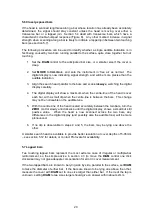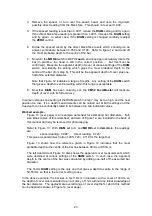
27
Non-magnetic metals
Signals from copper and brass are weaker then those from ordinary iron and steel. To
obtain sufficient signals for location and depth measurement, the DIAM control needs to
be set to a much lower value than the true diameter. The optimum value must be
determined by experiments with uncovered samples.
Stainless steel
is a special case— for advice contact
Protovale
.
With non-magnetic bars and tubes, the ability of the search head to distinguish between
lengthwise and transverse bars is largely lost.
5.11 Magnetic aggregates
Certain types of aggregate such as ‘Lytag’ contain sintered iron oxide and give a
significant signal in the absence of any reinforcing bars. The effect of magnetic
aggregates on cover readings is negligible for depths less than 50-60mm (depending on
the bar size), so compensation procedures are only necessary for depths greater than 60-
70mm.
To check for the presence of a magnetic aggregate, zero the instrument as usual in ‘free
air’ and take a depth measurement on a bar. Insert a spacer of known thickness (10-
12mm) and take another reading. If the difference between the two readings exceeds the
spacer thickness by more than 2-3mm, readings are being affected by a magnetic
aggregate and the following steps should be taken.
The ideal way to compensate for magnetic aggregates is to zero the
CM52 CoverMaster
with the search head placed on a section of the concrete which does not contain
reinforcing bars. When zeroed in this manner, the instrument will read the correct depth
of cover for reinforcing bars.
In practice a section of reinforcement-free concrete may not be available, but an
alternative procedure is available for small to medium-sized bars.
1. Locate a reinforcing bar and position the search head accurately over the bar and
parallel to it.
2. Turn
the
MODE
switch to the
CALib
rate position, rotate the search head by 90
and carefully adjust the angle for minimum reading on the digital display. Do not
move the search head sideways– only rotate it.
3. Now zero the instrument. On switching to
DEPth
, it will indicate cover to within
1mm of the correct reading.
CAUTION– Do not use this procedure if the bar is known or expected to be large,
because it tends to over-compensate under these conditions.
Содержание Protovale CoverMaster CM52
Страница 1: ...Elcometer P350 Protovale CM52 Covermeter Operating Instructions...
Страница 4: ......
Страница 25: ...22 Figure 12 Reference graph for recommended method of estimating bar size...
Страница 27: ...24 Figure 13 Example worksheet...







































